
The 1876 United States presidential election was the 23rd quadrennial presidential election, held on Tuesday, November 7, 1876, in which Republican nominee Rutherford B. Hayes faced Democrat Samuel J. Tilden. It was one of the most contentious presidential elections in American history. Its resolution involved negotiations between the Republicans and Democrats, resulting in the Compromise of 1877, and on March 2, 1877, the counting of electoral votes by the House and Senate occurred, confirming Hayes as President. It was the second of five U.S. presidential elections in which the winner did not win a plurality of the national popular vote.

The Bland–Allison Act, also referred to as the Grand Bland Plan of 1878, was an act of the United States Congress requiring the U.S. Treasury to buy a certain amount of silver and put it into circulation as silver dollars. Though the bill was vetoed by President Rutherford B. Hayes, the Congress overrode Hayes's veto on February 28, 1878, to enact the law. The text of the act can be found in the Congressional Record under the further reading section of this article.

The Pendleton Civil Service Reform Act is a United States federal law passed by the 47th United States Congress and signed into law by President Chester A. Arthur on January 16, 1883. The act mandates that most positions within the federal government should be awarded on the basis of merit instead of political patronage.

Lucy Ware Hayes was the wife of President Rutherford B. Hayes and served as first lady of the United States from 1877 to 1881.
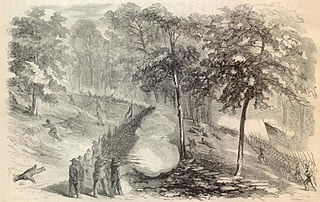
The Battle of South Mountain—known in several early Southern accounts as the Battle of Boonsboro Gap—was fought on September 14, 1862, as part of the Maryland campaign of the American Civil War. Three pitched battles were fought for possession of three South Mountain passes: Crampton's, Turner's, and Fox's Gaps. Maj. Gen. George B. McClellan, commanding the Union Army of the Potomac, needed to pass through these gaps in his pursuit of Confederate General Robert E. Lee's precariously divided Army of Northern Virginia. Although the delay bought at South Mountain would allow him to reunite his army and forestall defeat in detail, Lee considered termination of the Maryland Campaign at nightfall.
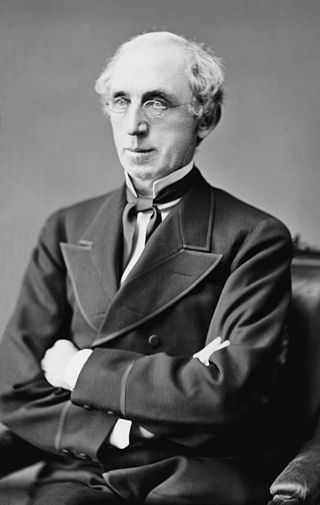
Henry B. Payne was an American politician from Ohio. Moving to Ohio from his native New York in 1833, he quickly established himself in law and business while becoming a local leader in Democratic politics. After serving in the Ohio Senate, Payne was elected to a single term in the United States House of Representatives in 1874. In the House, he worked unsuccessfully for a compromise in the debate over whether all of the nation's currency should be backed by gold. He was defeated for reelection, but served on the Electoral Commission that convened in early 1877 to resolve the dispute over the results of the 1876 presidential election.

Gustavus Vasa Fox was an officer of the United States Navy, who served during the Mexican–American War, and as the first Assistant Secretary of the Navy during the Civil War.

The Electoral Commission, sometimes referred to as the Hayes-Tilden or Tilden-Hayes Electoral Commission, was a temporary body created by the United States Congress on January 29, 1877, to resolve the disputed United States presidential election of 1876. Democrat Samuel J. Tilden and Republican Rutherford B. Hayes were the main contenders in the election. Tilden won 184 undisputed electoral votes, one vote shy of the 185 needed to win, to Hayes' 165, with 20 electoral votes from four states unresolved. Both Tilden and Hayes electors submitted votes from these states, and each claimed victory.

The Rutherford B. Hayes Presidential Center is a complex comprising several buildings related to the life and presidency of Rutherford B. Hayes. It is the first presidential library, built in 1916, and one of three such libraries for US presidents during the 19th century.
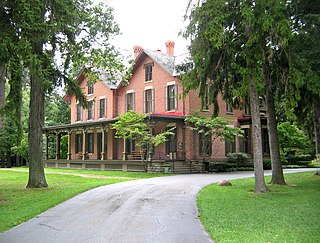
Spiegel Grove, also known as Spiegel Grove State Park, Rutherford B. Hayes House, Rutherford B. Hayes Summer Home and Rutherford B. Hayes State Memorial was the estate of Rutherford B. Hayes, the 19th president of the United States, located at the corner of Hayes and Buckland Avenues in Fremont, Ohio. Spiegel is the German and Dutch word for mirror. The traditional story is that the estate was named by Hayes' uncle Sardis Birchard, who first built it for his own residence. He named it for the reflective pools of water that collected on the property after a rain shower.
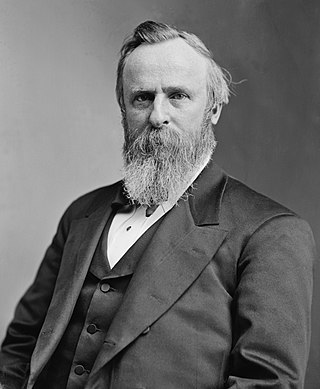
The presidency of Rutherford B. Hayes began on March 4, 1877, when Rutherford B. Hayes was inaugurated as President of the United States, and ended on March 4, 1881. Hayes became the 19th president, after being awarded the closely contested 1876 presidential election by Republicans in Congress who agreed to the Compromise of 1877. That Compromise promised to pull federal troops out of the South, thus ending Reconstruction. He refused to seek re-election and was succeeded by James A. Garfield, a fellow Republican and ally.

Dr. Harvey Willard Curtiss was a Republican legislator from the U.S. state of Ohio who, as the president of the Ohio Senate, became the 13th lieutenant governor of Ohio 1877–1878 when the governor resigned, and the previous lieutenant governor succeeded to the governorship.

Rutherford Birchard Hayes was an American lawyer and politician who served as the 19th president of the United States from 1877 to 1881, after serving in the U.S. House of Representatives and as governor of Ohio. Before the American Civil War, Hayes was a lawyer and staunch abolitionist who defended refugee slaves in court proceedings. He served in the Union Army and the House of Representatives before assuming the presidency. His presidency represents a turning point in U.S. history, as historians consider it the formal end of Reconstruction. Hayes, a prominent member of the Republican "Half-Breed" faction, placated both Southern Democrats and Whiggish Republican businessmen by ending the federal government's involvement in the South.
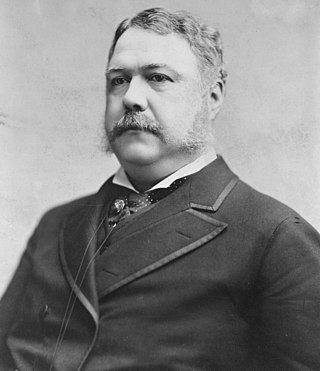
Chester Alan Arthur was an American politician who served as the 21st president of the United States from 1881 to 1885. He was a Republican lawyer from New York who previously served as the 20th vice president under President James A. Garfield. Arthur assumed the presidency after Garfield's death on September 19, 1881, and served the remainder of his term until March 4, 1885.
Events from the year 1877 in the United States.
Hans Louis Trefousse (December 18, 1921, Frankfurt/Main, Germany – January 8, 2010, Staten Island, New York was a German-born American author and historian of the Reconstruction Era and World War II. He was a long time professor at Brooklyn College, from 1950 to 1998. He also taught as a distinguished professor of history at City University of New York.

Brian Patrick Lamb is an American journalist. He is the founder, executive chairman, and the now-retired CEO of C-SPAN, an American cable network that provides coverage of the U.S. House of Representatives and U.S. Senate as well as other public affairs events. In 2007, Lamb was awarded Presidential Medal of Freedom by President George W. Bush and received the National Humanities Medal the following year.
Thomas Harry Williams was an American academic and author. For the majority of his academic career between the 1930s to 1970s, Williams taught history at Louisiana State University. While at LSU, Williams was a Boyd Professor of History from 1953 to 1979. Near the end of his tenure at LSU, the university created the T. Harry Williams Chair of American History. Additional academic institutes Williams taught at include extension schools, in Wisconsin and at the Municipal University of Omaha.













